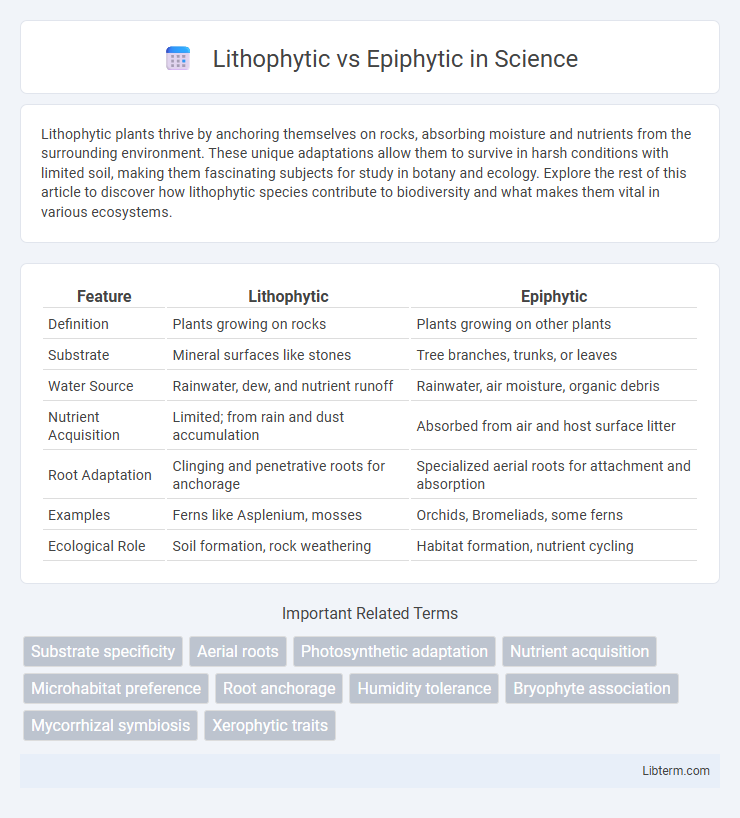Lithophytic plants thrive by anchoring themselves on rocks, absorbing moisture and nutrients from the surrounding environment. These unique adaptations allow them to survive in harsh conditions with limited soil, making them fascinating subjects for study in botany and ecology. Explore the rest of this article to discover how lithophytic species contribute to biodiversity and what makes them vital in various ecosystems.
Table of Comparison
| Feature | Lithophytic | Epiphytic |
|---|---|---|
| Definition | Plants growing on rocks | Plants growing on other plants |
| Substrate | Mineral surfaces like stones | Tree branches, trunks, or leaves |
| Water Source | Rainwater, dew, and nutrient runoff | Rainwater, air moisture, organic debris |
| Nutrient Acquisition | Limited; from rain and dust accumulation | Absorbed from air and host surface litter |
| Root Adaptation | Clinging and penetrative roots for anchorage | Specialized aerial roots for attachment and absorption |
| Examples | Ferns like Asplenium, mosses | Orchids, Bromeliads, some ferns |
| Ecological Role | Soil formation, rock weathering | Habitat formation, nutrient cycling |
Introduction to Lithophytic and Epiphytic Plants
Lithophytic plants grow on rocks, deriving nutrients from rainwater, air, and organic debris, adapting to harsh, nutrient-poor environments with specialized root systems. Epiphytic plants live on other plants, especially trees, without parasitizing them, acquiring moisture and nutrients from the air and surrounding debris through adapted aerial roots. Both plant types exemplify unique survival strategies in ecosystems, contributing to biodiversity and ecological balance.
Defining Lithophytic Plants: Key Characteristics
Lithophytic plants grow directly on rocks or rocky substrates, relying on minimal soil or organic matter for nutrients. These plants exhibit specialized root systems capable of anchoring securely and absorbing moisture from rain, dew, or nearby organic debris. Adaptations such as drought tolerance and slow growth enable lithophytes to thrive in nutrient-poor, exposed environments.
Understanding Epiphytic Plants: Unique Features
Epiphytic plants adapt by growing on other plants, mainly trees, without drawing nutrients from the soil, utilizing aerial roots to absorb moisture and nutrients from the air and debris. Unlike lithophytic plants, which thrive on rocks, epiphytes possess specialized structures like velamen roots that enhance water retention and gas exchange in their elevated habitats. These unique features enable epiphytes, including orchids, bromeliads, and ferns, to exploit light-rich canopy environments inaccessible to ground-rooted species.
Natural Habitats: Where Lithophytes and Epiphytes Thrive
Lithophytes thrive on rocky substrates, utilizing minimal soil and extracting nutrients from crevices in limestone or granite formations commonly found in mountainous or arid regions. Epiphytes grow on the surface of other plants, especially tree branches and trunks, in humid tropical rainforests where they absorb moisture and nutrients from the air and organic debris. Both adapt to environments with limited soil but differ in their structural support and nutrient acquisition methods specific to their natural habitats.
Nutritional Strategies: How Lithophytes and Epiphytes Survive
Lithophytes obtain nutrients by anchoring themselves on rocks, absorbing minerals and moisture from rainwater, dust, and decomposing organic material in crevices. Epiphytes survive by growing on other plants, primarily trees, extracting nutrients and water from the air, rain, and accumulated debris, without parasitizing their hosts. Both strategies enable these plants to thrive in nutrient-poor environments by maximizing resource capture from non-soil substrates.
Adaptations for Water and Nutrient Acquisition
Lithophytic plants adapt to growing on rocks by developing specialized root systems that absorb moisture from rain, dew, and organic debris collected in crevices, while storing water in thickened tissues to withstand drought. Epiphytic plants, often found on tree branches, possess aerial roots covered with velamen, a spongy tissue that enhances water absorption from humidity and rainfall, alongside symbiotic relationships with fungi to aid nutrient uptake. Both plant types exhibit morphological and physiological adaptations to acquire limited water and nutrients from their unconventional habitats, ensuring survival in nutrient-poor environments.
Common Examples of Lithophytic vs Epiphytic Species
Common lithophytic species include the rock-dwelling orchids Dendrobium and Paphiopedilum, as well as mosses like Grimmia that thrive on rocky substrates. Epiphytic species commonly found in tropical rainforests include orchids such as Phalaenopsis and Vanda, as well as bromeliads like Tillandsia, which grow on the surfaces of trees without harming their hosts. Both lithophytes and epiphytes have adapted unique root structures to anchor themselves and absorb moisture and nutrients from their specific environments.
Ecological Roles and Environmental Impact
Lithophytic plants grow on rocks and contribute to nutrient cycling by breaking down mineral surfaces, which aids in soil formation and prevents erosion. Epiphytic plants live on other plants without harming them, enhancing biodiversity and providing microhabitats for various insects and microorganisms. Both growth forms support ecosystem stability by facilitating nutrient exchange and offering refuge to diverse species in forest canopies and rocky environments.
Growth Requirements and Care in Cultivation
Lithophytic plants thrive on rocks, requiring well-drained substrates with minimal organic matter and frequent misting to maintain humidity, while epiphytic plants grow on trees, needing organic-rich, airy mediums like bark and consistent moisture without waterlogging. Lithophytes demand strong light and good air circulation to prevent rot, whereas epiphytes require indirect light and high humidity to mimic forest canopy conditions. Both types benefit from regular feeding with diluted, balanced fertilizers to support growth and reproduction.
Comparing Lithophytes and Epiphytes: Key Differences and Similarities
Lithophytes grow on rocks, deriving nutrients from rainwater, moss, and organic debris, while epiphytes grow on other plants, mainly trees, without parasitizing them. Both adapt to nutrient-poor environments by absorbing moisture and nutrients from the air and rain, and they contribute to ecosystem biodiversity by providing habitats for various organisms. Lithophytes typically endure harsher, more exposed conditions, whereas epiphytes benefit from elevated positions that offer better access to light.
Lithophytic Infographic

 libterm.com
libterm.com